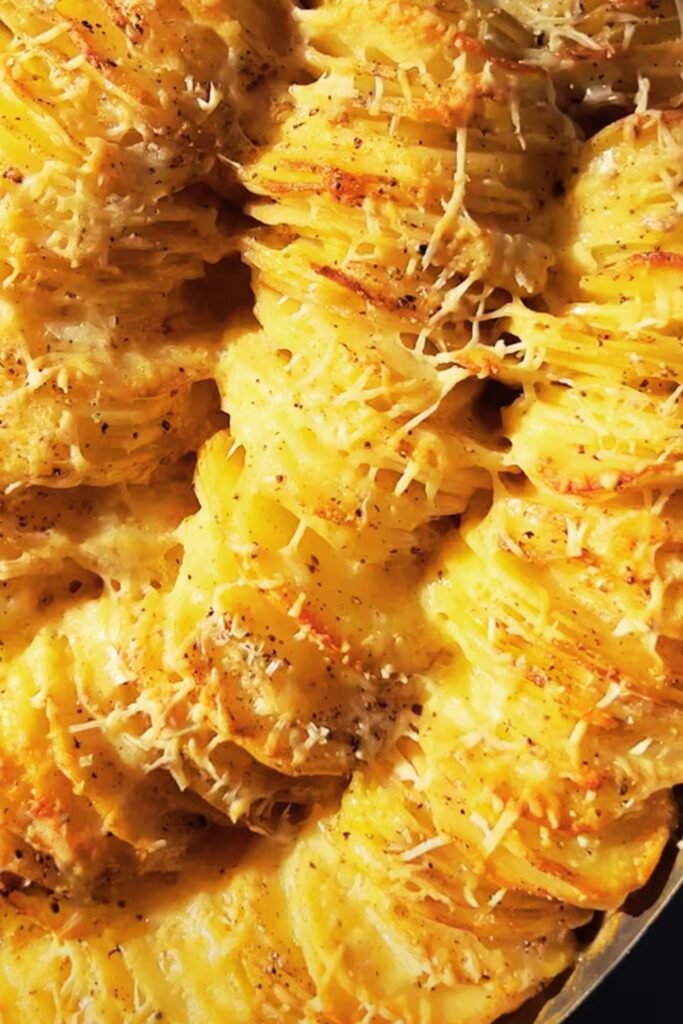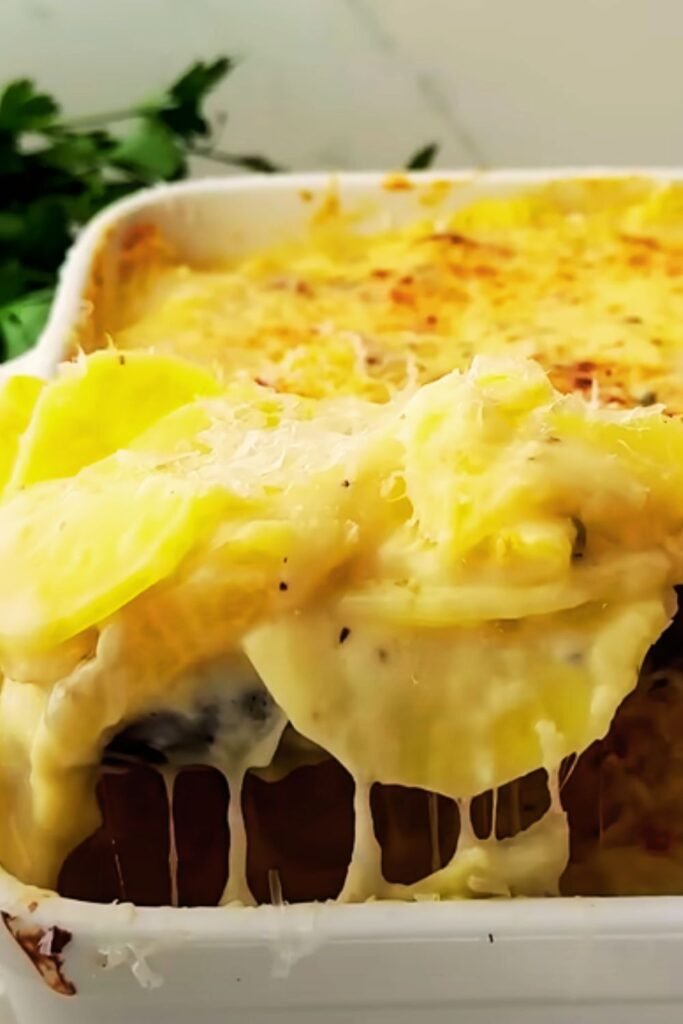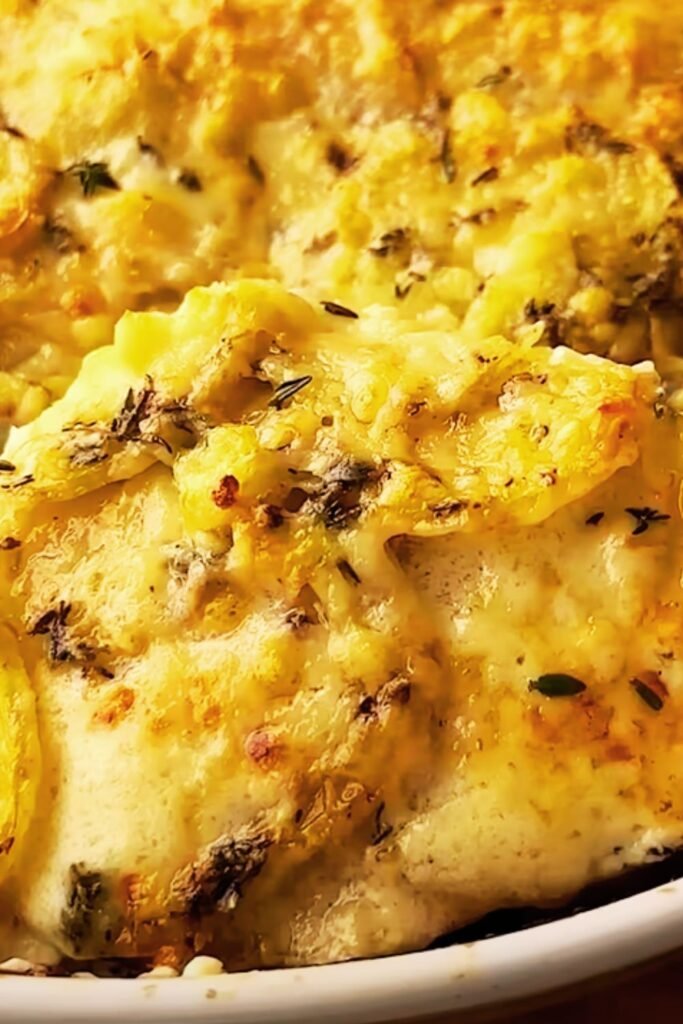When I first tasted the legendary potatoes au gratin at Ruth’s Chris Steakhouse, I knew I had to recreate this masterpiece in my own kitchen. These aren’t your ordinary scalloped potatoes – they’re a luxurious, creamy symphony of perfectly layered Yukon Gold potatoes swimming in the richest cheese sauce you can imagine. After countless attempts and kitchen experiments, I’ve finally cracked the code to this steakhouse secret.
The beauty of Ruth’s Chris potatoes lies in their perfect balance of textures and flavors. Each bite delivers tender, buttery potatoes enveloped in a velvety cheese sauce that’s been elevated with heavy cream and a touch of nutmeg. What sets these apart from typical au gratin recipes is the restaurant’s technique of using multiple cheese varieties and a precise layering method that ensures every forkful is absolutely divine.
Understanding the Ruth’s Chris Magic
Au gratin: A French culinary term referring to a dish topped with cheese or breadcrumbs and browned under a broiler or in an oven
Roux: A mixture of equal parts flour and fat (butter) cooked together to thicken sauces
Mornay sauce: A cheese sauce made from a béchamel base, typically using Gruyère or similar cheeses
Mandoline: A kitchen tool for creating uniform, thin slices of vegetables
The secret to replicating Ruth’s Chris potatoes starts with understanding their approach. Unlike many home recipes that rely on simple cream and cheese, this steakhouse version uses a proper Mornay sauce base. This French technique creates an incredibly smooth, rich foundation that coats every potato slice evenly.
Essential Ingredients Breakdown
| Ingredient | Quantity | Purpose | Substitution Options |
|---|---|---|---|
| Yukon Gold Potatoes | 3 pounds | Main ingredient, creamy texture | Russet (less creamy), Red potatoes |
| Heavy Cream | 2 cups | Rich base, smooth texture | Half-and-half (lighter result) |
| Whole Milk | 1 cup | Sauce consistency | 2% milk acceptable |
| Gruyère Cheese | 8 oz, grated | Primary flavor, melts smoothly | Swiss cheese, Emmental |
| Sharp Cheddar | 4 oz, grated | Bold flavor accent | Medium cheddar, aged white cheddar |
| Parmesan | 1/2 cup, grated | Umami depth, browning | Pecorino Romano |
| Butter | 6 tablespoons | Roux base, richness | European-style butter preferred |
| All-purpose Flour | 1/4 cup | Thickening agent | Wondra flour for smoother texture |
| Fresh Thyme | 2 teaspoons | Aromatic herbs | Dried thyme (1 tsp) |
| Nutmeg | 1/4 teaspoon | Warm spice note | Fresh grated preferred |
| Garlic | 3 cloves, minced | Savory depth | Garlic powder (1 tsp) |
| Salt | To taste | Flavor enhancement | Sea salt or kosher salt |
| White Pepper | 1/4 teaspoon | Heat without color | Black pepper acceptable |

Step-by-Step Preparation Method
Preparing the Potatoes
I always start by selecting the right potatoes. Yukon Golds are non-negotiable for this recipe – their naturally buttery flavor and creamy texture when cooked make them perfect for au gratin dishes. Russets tend to fall apart, while red potatoes can be too waxy.
Here’s my foolproof potato prep method:
- Wash and peel 3 pounds of Yukon Gold potatoes
- Using a mandoline or sharp knife, slice potatoes into uniform 1/8-inch thick rounds
- Immediately place sliced potatoes in cold water to prevent browning
- Pat completely dry with clean kitchen towels before layering
The uniform thickness is crucial – it ensures even cooking throughout the dish. I learned this the hard way after serving potatoes that were perfectly tender on top but still firm underneath.
Creating the Perfect Mornay Sauce
This is where the magic happens. The sauce makes or breaks this dish, and I’ve perfected the technique through years of trial and error.
Step 1: Building the Roux
- Melt 6 tablespoons of butter in a heavy-bottomed saucepan over medium heat
- Whisk in 1/4 cup flour gradually, cooking for 2-3 minutes until golden
- The mixture should smell nutty, not raw
Step 2: Adding Liquid Components
- Slowly whisk in the milk, ensuring no lumps form
- Gradually add the heavy cream while whisking constantly
- Add minced garlic, thyme, nutmeg, salt, and white pepper
- Simmer for 5-7 minutes until thickened
Step 3: Cheese Integration
- Remove from heat and add Gruyère cheese gradually, whisking until smooth
- Incorporate sharp cheddar in the same manner
- Add half the Parmesan, reserving the rest for topping
- Taste and adjust seasoning
The key is removing the sauce from heat before adding cheese – this prevents the proteins from seizing and creating a grainy texture.
Assembly Technique

My layering method is inspired by the restaurant’s precise technique:
Layer 1 (Bottom)
- Butter a 9×13-inch baking dish generously
- Arrange 1/3 of the potato slices in overlapping rows
- Pour 1/3 of the cheese sauce evenly over potatoes
- Gently press down to eliminate air pockets
Layer 2 (Middle)
- Repeat with another 1/3 of potatoes
- Add another 1/3 of sauce
- Press gently again
Layer 3 (Top)
- Final layer of potatoes in an attractive pattern
- Remaining sauce should just cover the top layer
- Sprinkle reserved Parmesan cheese evenly
The pressing technique is something I picked up from a former Ruth’s Chris cook – it ensures the sauce penetrates between layers and creates that signature creamy interior.
Baking Instructions and Temperature Control
| Baking Phase | Temperature | Time | Visual Cues |
|---|---|---|---|
| Initial Bake | 350°F | 45 minutes | Bubbling edges, set center |
| Browning Phase | 425°F | 10-15 minutes | Golden brown top |
| Resting Period | Off | 10 minutes | Firms up for clean slices |
Preheat your oven to 350°F and position the rack in the center. Cover the dish tightly with foil for the first 45 minutes – this prevents the top from browning too quickly while the interior cooks through.
After 45 minutes, remove the foil and increase temperature to 425°F. This final high-heat phase creates that gorgeous golden-brown top that Ruth’s Chris is famous for. The surface should be bubbly and beautifully caramelized.
I always test doneness by inserting a knife into the center – it should slide through effortlessly with no resistance from the potatoes.
Professional Tips and Techniques
Through my years of perfecting this recipe, I’ve discovered several game-changing techniques:
Cheese Selection Strategy The combination of Gruyère, sharp cheddar, and Parmesan isn’t arbitrary. Gruyère provides nutty complexity and superior melting properties. Sharp cheddar adds bold flavor that cuts through the richness. Parmesan contributes umami depth and helps achieve that golden top.
Cream Temperature Matters I always bring my cream and milk to room temperature before making the sauce. Cold dairy can cause the roux to seize, creating lumps that are difficult to smooth out.
Make-Ahead Success This dish actually improves when made a day ahead. The flavors meld beautifully overnight, and the potatoes absorb more of that incredible sauce. Simply cover and refrigerate, then bring to room temperature before reheating at 350°F for 20-25 minutes.
Portion Control Wisdom Ruth’s Chris serves this as a side dish, and trust me, a little goes a long way. I typically plan for about 1/2 cup per person when serving alongside other rich dishes.
Nutritional Information and Dietary Considerations
| Nutrient | Per Serving (1/8 recipe) | Daily Value % |
|---|---|---|
| Calories | 385 | 19% |
| Total Fat | 28g | 43% |
| Saturated Fat | 18g | 90% |
| Cholesterol | 85mg | 28% |
| Sodium | 420mg | 18% |
| Carbohydrates | 24g | 8% |
| Protein | 15g | 30% |
| Calcium | 350mg | 35% |
This is definitely an indulgent dish, and I always remind people that it’s meant to be a special occasion side. The high fat content comes primarily from the cheese and cream, which contribute to the luxurious texture and flavor.
Dietary Modifications I’ve Tested:
- Lower Fat Version: Half-and-half instead of heavy cream reduces calories by about 80 per serving
- Gluten-Free Option: Substitute flour with cornstarch (use 2 tablespoons instead of 1/4 cup flour)
- Reduced Sodium: Use low-sodium cheese varieties and reduce added salt
Troubleshooting Common Issues

Problem: Grainy or broken sauce Solution: This usually happens when cheese is added to sauce that’s too hot, or when the sauce boils after cheese addition. Always remove from heat before adding cheese, and reheat gently if needed.
Problem: Watery final dish Solution: Ensure potatoes are completely dry before layering, and let the sauce thicken properly. If it’s too thin, cook the sauce longer before assembly.
Problem: Uneven cooking Solution: Uniform potato slices are crucial. Invest in a mandoline for consistent results. Also, ensure your baking dish distributes heat evenly.
Problem: Burnt top, undercooked center Solution: Cover with foil for most of the baking time, only removing it for the final browning phase.
Serving Suggestions and Pairings
This rich, indulgent side dish pairs beautifully with simple, well-seasoned proteins. At Ruth’s Chris, it’s traditionally served alongside their famous steaks, but I’ve found it complements many dishes:
Perfect Protein Pairings:
- Grilled or pan-seared steaks (filet mignon, ribeye, New York strip)
- Roasted chicken or turkey
- Grilled salmon or halibut
- Pork tenderloin or chops
- Prime rib or beef tenderloin
Vegetable Companions:
- Simple steamed asparagus
- Roasted Brussels sprouts
- Grilled zucchini and yellow squash
- Fresh green salad with vinaigrette
- Sautéed spinach with garlic
Timing for Dinner Parties: I always prepare this dish first when hosting, as it holds well in a warm oven while I finish other components. It can stay warm at 200°F for up to 30 minutes without compromising quality.
Storage and Reheating Guidelines
| Storage Method | Duration | Reheating Instructions |
|---|---|---|
| Refrigerator | 3-4 days | 350°F for 20-25 minutes, covered |
| Freezer | Up to 2 months | Thaw overnight, reheat as above |
| Individual Portions | 3 days | Microwave 1-2 minutes, then oven-crisp |
Proper Storage Technique: Allow the dish to cool completely before covering tightly with plastic wrap or transferring to airtight containers. For freezing, I recommend dividing into smaller portions for easier reheating.
Reheating for Best Results: Never microwave the entire dish – it creates uneven heating and can make the sauce separate. Instead, reheat covered in the oven until warmed through, then uncover for the last few minutes to re-crisp the top.
Advanced Variations and Flavor Enhancements
Over the years, I’ve experimented with several variations that maintain the essence of Ruth’s Chris while adding personal touches:
Truffle Enhancement: Add 1-2 tablespoons of truffle oil to the sauce or shave fresh truffles over the finished dish. This elevates it to restaurant-quality luxury.
Herb Variations: Fresh rosemary or sage can replace thyme for different flavor profiles. I particularly love rosemary when serving with lamb.
Potato Combinations: Mix Yukon Golds with sweet potatoes (2:1 ratio) for added complexity and beautiful color contrast.
Cheese Upgrades: Substitute aged Manchego or aged Gouda for the Gruyère to create unique flavor profiles while maintaining excellent melting properties.
Questions and Answers
Q: Can I make this dish ahead of time for a dinner party? Absolutely! I actually prefer making it a day ahead. The flavors develop beautifully overnight, and it saves precious time on the day of your event. Just bring it to room temperature before reheating, and you’ll have restaurant-quality results.
Q: Why do my potatoes au gratin sometimes turn out watery? The most common cause is not drying the sliced potatoes thoroughly before layering. I always pat them completely dry with clean kitchen towels. Also, make sure your sauce has thickened properly before assembly – it should coat the back of a spoon nicely.
Q: What’s the best way to slice potatoes uniformly for this recipe? I swear by my mandoline slicer set to 1/8-inch thickness. It creates perfectly even slices that cook uniformly. If you don’t have one, use your sharpest knife and take your time – consistency is key to even cooking.
Q: Can I substitute different types of cheese? While I recommend sticking close to the original combination, you can experiment with similar melting cheeses. Emmental works well in place of Gruyère, and aged white cheddar can substitute for sharp cheddar. Just avoid cheeses that don’t melt well, like fresh mozzarella or feta.
Q: How do I prevent the cheese sauce from becoming grainy? The secret is temperature control. Always remove your sauce from heat before adding any cheese, and add it gradually while whisking constantly. If your sauce does break, try whisking in a tablespoon of cold cream to bring it back together.
Q: What’s the ideal consistency for the cheese sauce before baking? The sauce should coat the back of a spoon but still pour easily. Think of it as slightly thicker than heavy cream but thinner than pudding. It will thicken further during baking as it reduces.
Q: Can I freeze leftover potatoes au gratin? Yes, but with some caveats. The texture changes slightly after freezing – it becomes a bit more grainy. For best results, freeze in individual portions and reheat directly from frozen at 350°F, covered, for about 30-40 minutes.
Q: How do I achieve that perfect golden-brown top like at Ruth’s Chris? The key is the final high-heat browning phase. After baking covered at 350°F, remove the foil and increase the temperature to 425°F for 10-15 minutes. Watch carefully – you want deep golden brown, not burnt.
Q: What size baking dish works best for this recipe? A 9×13-inch dish is perfect for this amount of ingredients. It provides the right depth for proper layering while ensuring even cooking. If you only have a deeper dish, you might need to increase the baking time slightly.
Q: How can I tell when the potatoes are fully cooked? Insert a thin knife into the center of the dish – it should slide through all layers effortlessly with no resistance. The top should be golden brown and bubbly around the edges, and the center should be set but still creamy.
This copycat recipe has become one of my most requested dishes, and I love how it brings that steakhouse experience right to my dining table. The combination of perfectly cooked potatoes and that incredible cheese sauce creates a side dish that’s worthy of any special occasion. With these detailed instructions and tips, you’ll be able to recreate Ruth’s Chris magic in your own kitchen, impressing family and friends with this restaurant-quality masterpiece.